
The Wooden churches of Maramureș in the Maramureș region of northern Transylvania are a group of almost one hundred Orthodox churches, and occasionally Greek-Catholic ones, of different architectural solutions from different periods and areas. The Maramureș churches are high timber constructions with characteristic tall, slim bell towers at the western end of the building. They are a particular vernacular expression of the cultural landscape of this mountainous area of northern Romania.
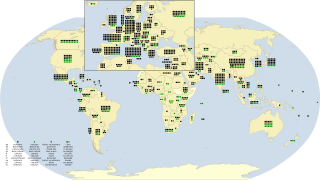
As of July 2019, there are a total of 1,121 World Heritage Sites located in 167 States Parties, of which 869 are cultural, 213 are natural and 39 are mixed properties. The countries have been divided by the World Heritage Committee into five geographic zones: Africa, Arab States, Asia and the Pacific, Europe and North America, and Latin America and the Caribbean. China and Italy have the highest number of World Heritage Sites, both with 55 entries. However, 27 state parties have no properties inscribed on the World Heritage List: Bahamas, Bhutan, Brunei, Burundi, Comoros, Cook Islands, Djibouti, Equatorial Guinea, Eswatini, Grenada, Guinea-Bissau, Guyana, Kuwait, Liberia, Maldives, Monaco, Niue, Rwanda, Saint Vincent and the Grenadines, Samoa, Sao Tome and Principe, Sierra Leone, Somalia, South Sudan, Timor-Leste, Tonga and Trinidad and Tobago.

Wooden Churches of Southern Lesser Poland of the UNESCO inscription are located in Binarowa, Blizne, Dębno, Haczów, Lipnica Murowana, and Sękowa. There are in fact many others of the region which fit the description: "The wooden churches of southern Little Poland represent outstanding examples of the different aspects of medieval church-building traditions in Roman Catholic culture. Built using the horizontal log technique, common in eastern and northern Europe since the Middle Ages..."

Poloniny National Park is a national park in northeastern Slovakia at the Polish and Ukrainian borders, in the Bukovské vrchy mountain range, which belongs to the Eastern Carpathians. It was created on 1 October 1997 with a protected area of 298.05 km2 (115.08 sq mi) and a buffer zone of 109.73 km2 (42.37 sq mi). Selected areas of the park are included into Primeval Beech Forests of the Carpathians UNESCO World Heritage Site.

Carpathian Wooden Churches is the name of a UNESCO World Heritage Site that consists of nine wooden religious buildings constructed between the 16th and 18th centuries in eight different locations in Slovakia. They include two Roman Catholic, three Protestant and three Greek Catholic churches plus one belfry in Hronsek. In addition to these churches there are about 50 more wooden churches in the territory of present-day Slovakia mainly in the northern and eastern part of the Prešov Region.

Wooden church architecture in Ukraine dates from the beginning of Christianity in the area and comprises a set of unique styles and forms specific to many sub-regions of the country. As a form of vernacular culture, construction of the churches in specific styles is passed on to subsequent generations. The architectural styles vary from very simple to complicated, involving a high degree of carpentry and wood-cutting artistry.
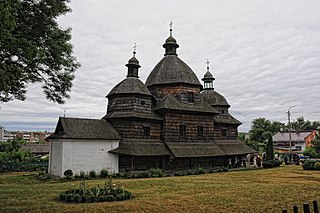
Wooden Holy Trinity Church was built in suburb of Zhovkva, Ukraine in 1720 on the place of a church that burned down in 1717. The structure consists of three wooden naves and a brick sacristy.

St. Michael Church was built in suburb of Uzhok, Ukraine in 1745. The structure consists of three wooden naves and a brick sacristy.
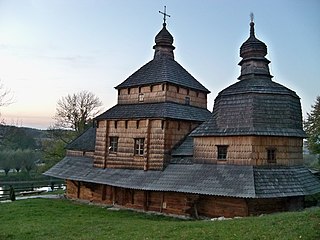
Wooden Descent of the Holy Spirit Church was built in suburb of Potelych, Ukraine in 1502 on the place of a church that was burned down by tatars. It is the oldest wooden church in Lviv Oblast. Church was visited by Bohdan Khmelnytsky

Matkiv is a village (selo) in Turka Raion, Lviv Oblast, in south-west Ukraine.
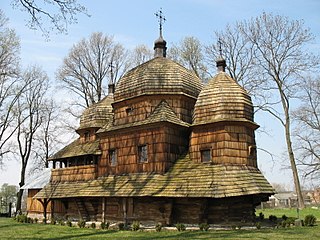
Mother of God Church in Chotyniec - a Gothic, wooden church located in the village of Chotyniec from the seventeenth-century, which together with different tserkvas is designated as part of the UNESCO Wooden tserkvas of the Carpathian region in Poland and Ukraine.
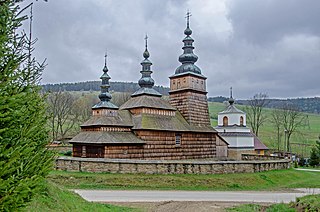
Protection of Our Most Holy Lady Church in Owczary - a Gothic, wooden church located in the village of Owczary from the seventeenth-century, which together with different tserkvas is designated as part of the UNESCO Wooden tserkvas of the Carpathian region in Poland and Ukraine.
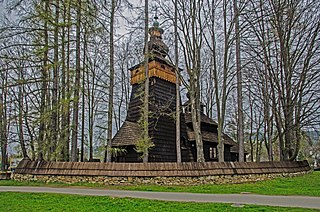
St. James Church is a Gothic, wooden church located in the village of Powroźnik, southern Poland. It dates from the seventeenth or eighteenth-century. Together with different tserkvas it is designated as part of the UNESCO World Heritage Site "Wooden tserkvas of the Carpathian region in Poland and Ukraine".
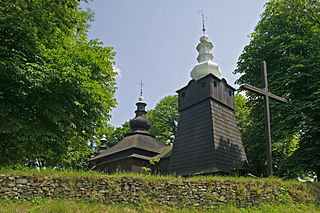
St. Michael Archangel's Church in Brunary is a Gothic, wooden church located in the village of Brunary from the eighteenth-century, which together with different tserkvas is designated as part of the UNESCO Wooden tserkvas of the Carpathian region in Poland and Ukraine.

St. Michael Archangel's Church in Smolnik - a Gothic, wooden church located in the village of Smolnik from the eighteenth-century, which together with different tserkvas is designated as part of the UNESCO Wooden tserkvas of the Carpathian region in Poland and Ukraine.

St. Michael Archangel's Church in Turzańsk - a Gothic, wooden church located in the village of Turzańsk from the nineteenth-century, which together with different tserkvas is designated as part of the UNESCO Wooden tserkvas of the Carpathian region in Poland and Ukraine.

St. Paraskevi Church in Kwiatoń - a Gothic, wooden church located in the village of Kwiatoń from the nineteenth-century, which together with different tserkvas is designated as part of the UNESCO Wooden tserkvas of the Carpathian region in Poland and Ukraine.



















